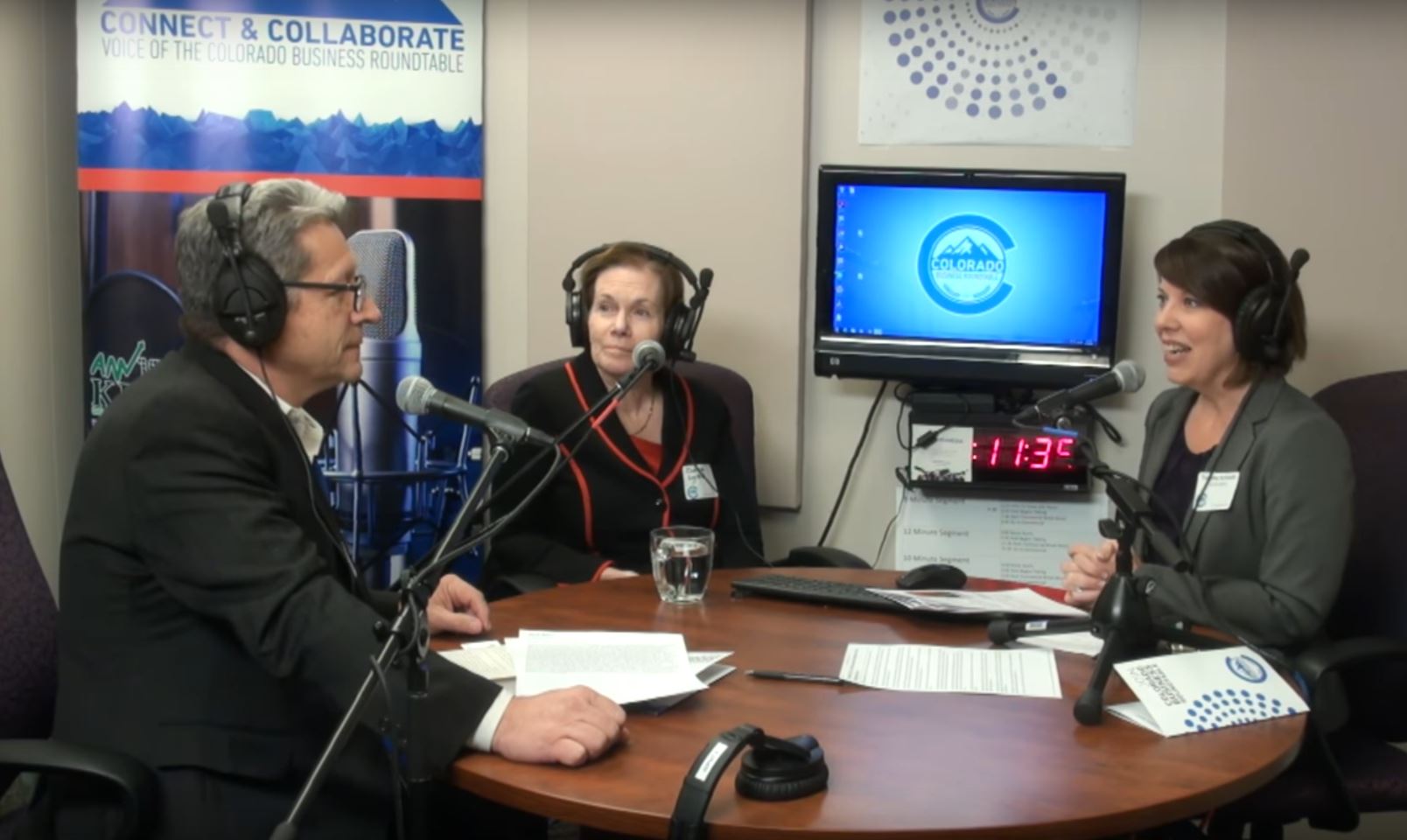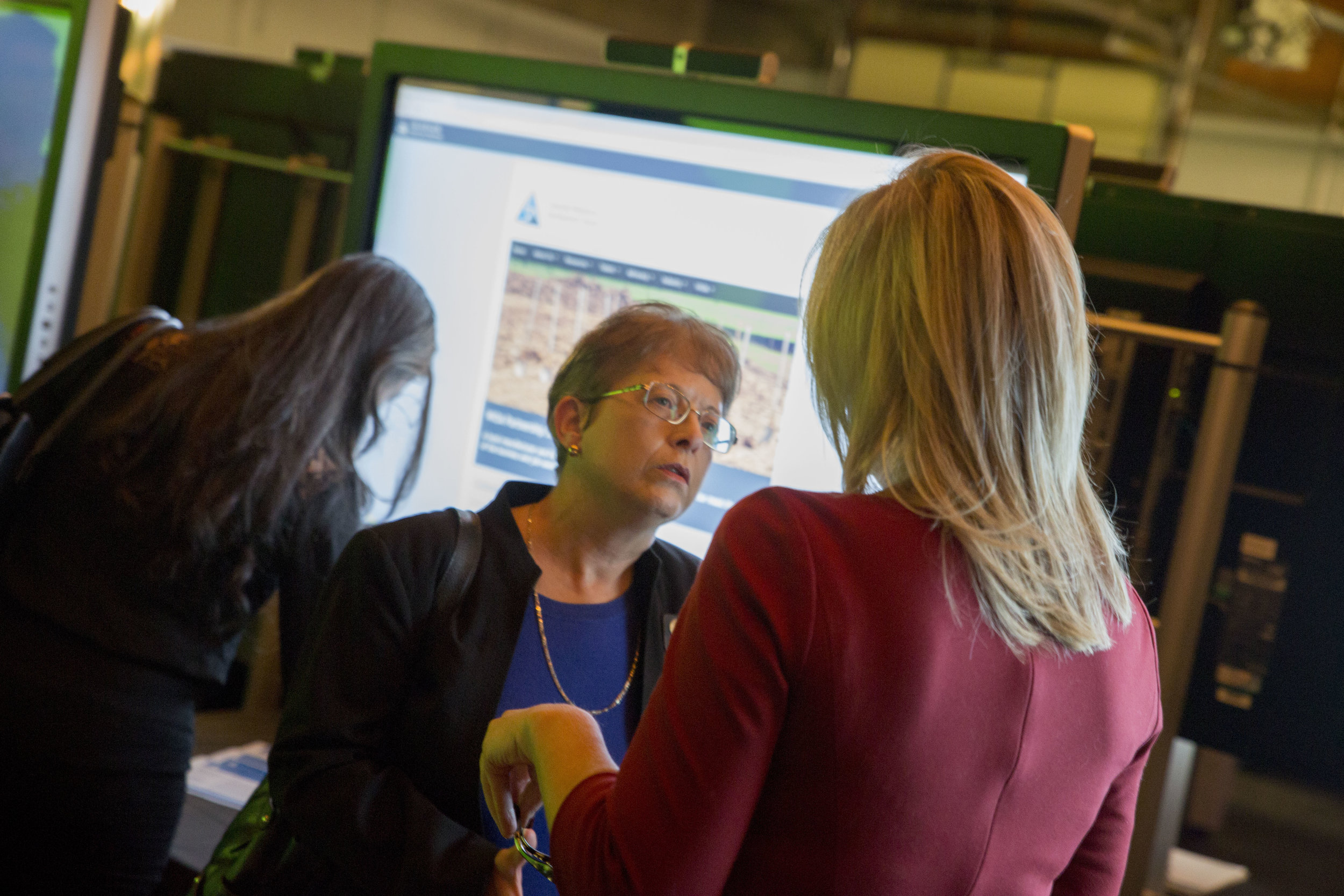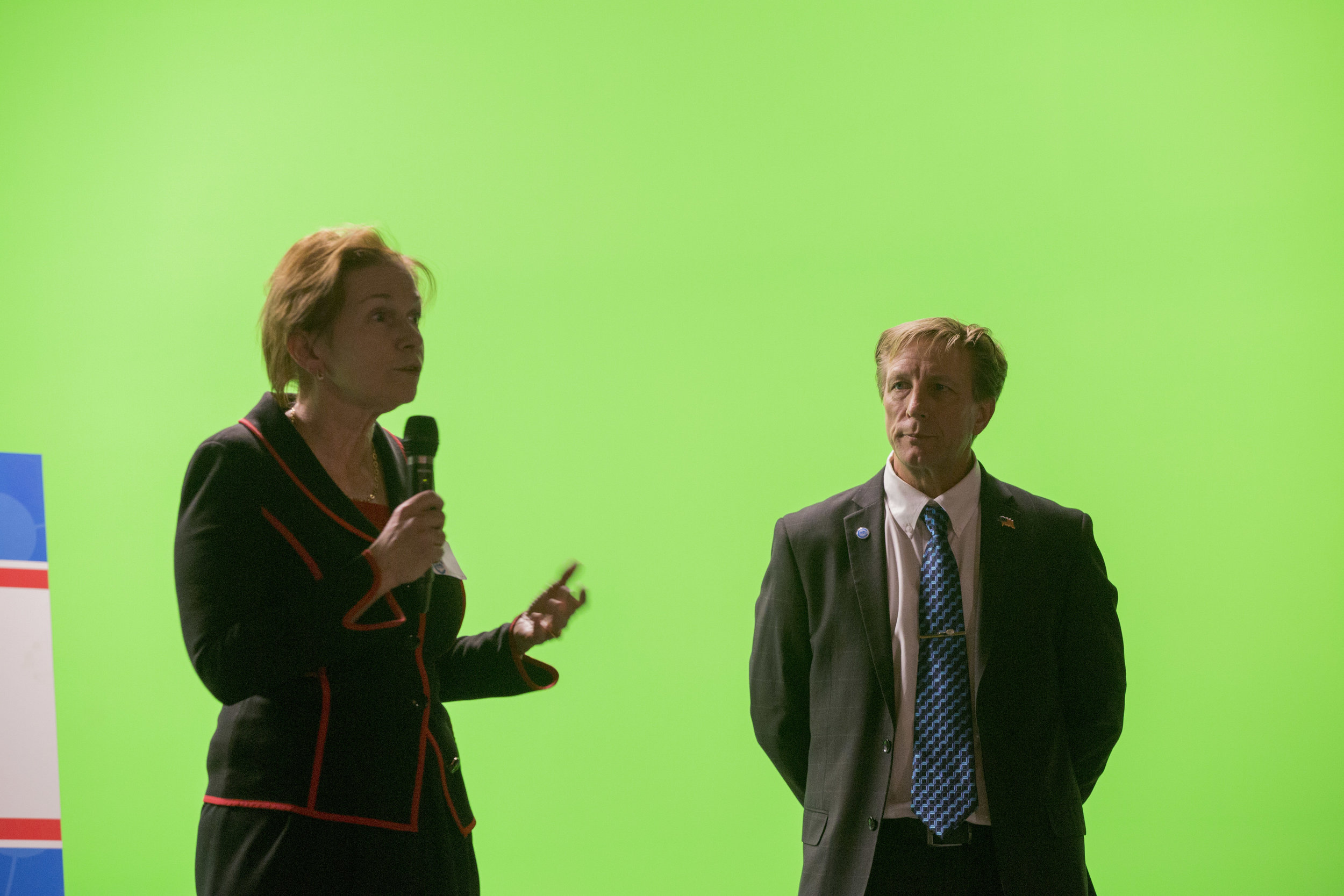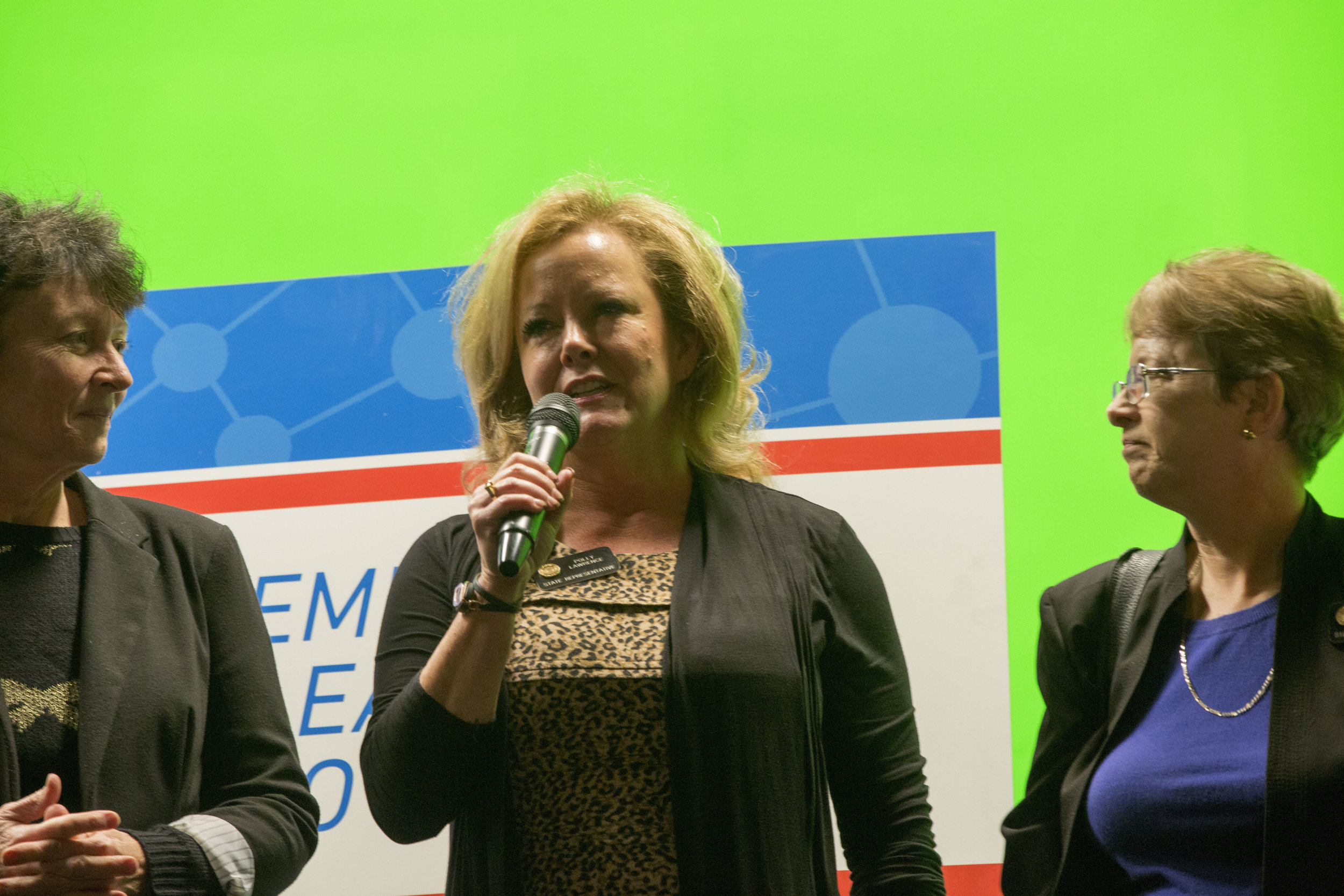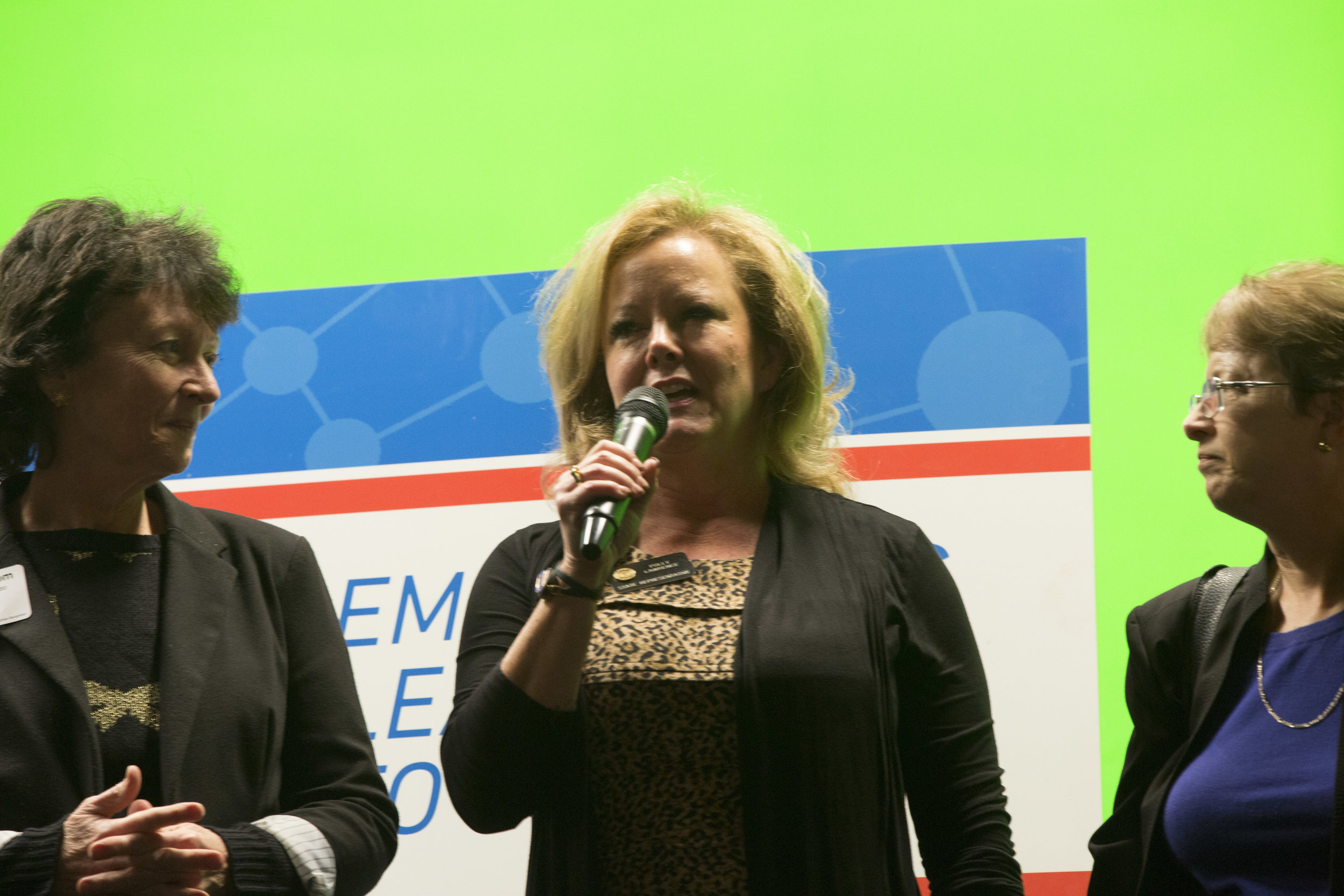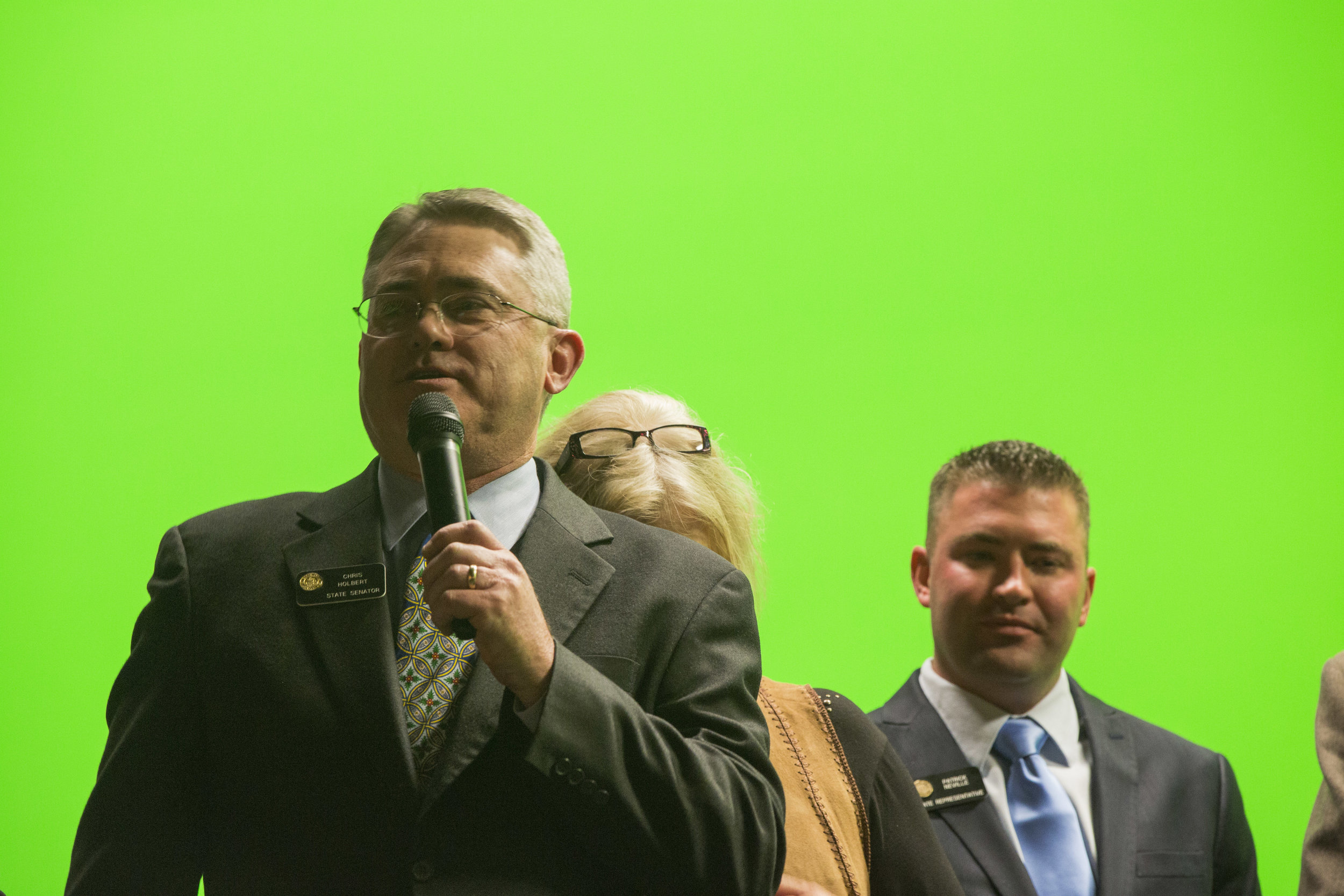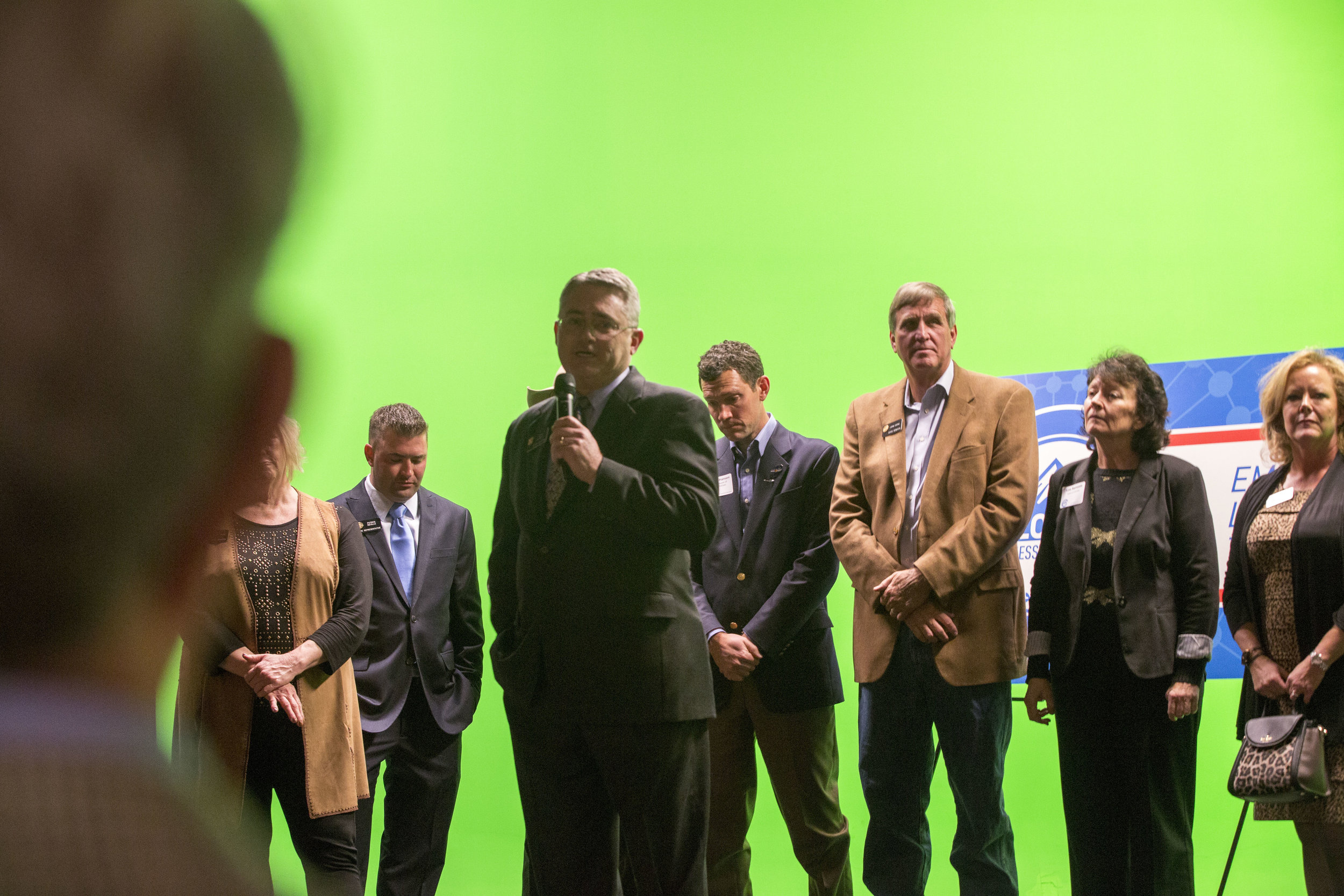BOULDER, Colo., April 21, 2017 -- Ball Corporation yesterday broke ground on an expansion of its Aerospace Manufacturing Center (AMC) at a groundbreaking ceremony in Westminster, CO. Colorado Governor John Hickenlooper, United States Representatives Mike Coffman (CO-6) and Ed Perlmutter (CO-7), and Westminster Mayor Herb Atchison joined senior Ball leadership for the event. When fully completed, the 145,000 square foot expansion will significantly enhance the manufacturing and production capabilities of Ball Aerospace, a business of Ball Corporation.
Read moreShared Website Live in Honor of Colorado Small Business Week
Shared website live in honor of Colorado Small Business Week
Small business appreciation week to take place April 30 - May 6, 2017
Denver - May 17, 2017 - The Colorado Small Business Development Center (COSBDC)along with several statewide small businesses, community organizations and financial institutions, launched a website in honor of National Small Business Week in Colorado.
Coloradosmallbizweek.com is where Coloradans can find all the events and celebrations in honor of small businesses in specific communities across the State. Celebrated during the first week of May, this year the US Small Business Administration's National Small Business Week occurs duringApril 30 - May 6, 2017.
"Small Business Week highlights the impact of entrepreneurs and small business owners across communities and the Colorado economy," said Stephanie Copeland, Executive Director of the Colorado Office of Economic Development and International Trade. "With over 560,000 smallbusinesses in Colorado and half of our workforce employed by small businesses, this week will celebrate their critical contributions with workshops, events and festivities to celebrate Colorado's entrepreneurial spirit."
The www.coloradosmallbizweek.com website features a calendar of the events, workshops, webinars and celebrations that will take place throughout Colorado during small business week. Events will continue to be added by participating organizations leading up to National SmallBusiness Week. Additionally, Coloradans can submit their own small business training events and celebrations to the website.
Every year since 1963, the President of the United States has declared a National Small Business Week to highlight the impact of outstanding entrepreneurs and small business owners across the nation.
Join the national conversation with the hashtag #SmallBizWeek. For questions about the SmallBusiness Week or about Colorado SBDC programs, please contact the SBDC navigator at
About the Colorado Small Business Development Center (SBDC) Network
The Colorado Small Business Development Center (SBDC) Network is dedicated to helping existing and new businesses grow and prosper in Colorado by providing free and confidential consulting and no-or low-cost training programs. The SBDC strives to be the premier, trusted choice of Colorado businesses for consulting, training and resources. The SBDC Network combines the resources of federal, state and local organizations with those of the educational system and private sector to meet the specialized and complex needs of the small business community.
Jim McNerney Presents at ACG Conference
Jim McNerney has been the CEO of multiple GE divisions (including GE Aircraft Engines and GE Lighting), the CEO of 3M, and -- most recently -- the CEO of Boeing. It is perhaps an understatement to say he has overseen a lot of growth in these roles. He also gained valuable experience in his earlier positions working with Procter & Gamble's brand management and as a management consultant for McKinsey & Company.
Mr. McNerney took to the stage earlier this month to address ACG Denver's 2017 Rocky Mountain Corporate Growth Conference audience by offering his rare insight into the leadership required of such roles and responsibilities:
Here are a few quotes and notes from his presentation:
- If you have no plan for growth, you have no plan.
- Focus on your customer and your people, period.
- 1% inspiration, 99% perspiration. Are you surrounded by workers?
- High risk can yield high returns, but remember, there is really only one risk manager in any company: the CEO.
- Management styles do not cross all disciplines. You many need people to help implement what dreamers dream.
- Dreamliner was a victim of overreach, not adapting with changing times. What saved us? Our culture and our people
- Create a team that believes in the mission, that shares the passion, and that buys into the direction.
- Avoid risk of over delegation- keep your eye on the ball.
- Why does the 747 still dominate today, well past its normal shelf life? We meet market requirements, cost competitive, minor tweaks to meet customer demands versus always chasing something new. When I was at 3M, we created 2,000 new products every year, almost to our demise.
- Measure your progress by your customers…. Not all of your own metrics.
- Constant improvement, motivated employees, culture, culture, culture- staples of a successful organization.
ACG Denver stands for the Association for Corporate Growth - Denver.
Check out their next upcoming event:
Gaining the Upper Hand in M&A:
How Well-Advised Buyers and Sellers Can Each Make the Process
Work for Them
Wednesday, May 17, 2017
7:30-9:00 a.m.
Embassy Suites
Downtown Convention Center
1420 Stout Street, Denver
Sellers and buyers have fundamentally different objectives. The “standard sale process” doesn’t always suit either party perfectly, and how can a particular party’s objectives best be met within that process while the other side is perhaps pulling in a different direction? Please join us for a fireside chat with nationally recognized experts from both sides who will discuss, in a point-counter-point fashion, today’s current M&A challenges, roles and goals that can either make or break a deal.
OEDIT Launches Next Round of Blueprint 2.0 Initiatives Based on Successes
Denver (April 4, 2017) - The Colorado Office of Economic Development and International Trade (OEDIT) today announced it is accepting applications for the next round of Blueprint 2.0 initiatives for 2017. Applications are due June 2.
"In our continued effort to identify opportunities for the entire state to share in our overall economic vitality, this program provides support to rural communities who are committed to strengthening their economy," said Gov. John Hickenlooper.
Blueprint 2.0 leverages state partnerships and specialized resources to address the unique economic development goals of rural Colorado. Blueprint 2.0 is a bottom-up effort to turn regional feedback on local economic needs into a statewide set of initiatives to advance the economies of rural communities.
"The first round of the Blueprint 2.0 initiatives were very successful and provided a framework for local communities to create plans that address their needs," said OEDIT executive director Stephanie Copeland. "We are excited to launch the next round and look forward to working with communities across the state."
Based on participant feedback, community successes and economic opportunities the next round of Blueprint 2.0 will offer 10 initiative options, with six new initiatives. The initiatives include:
Continued Initiatives:
- Brand Building for Communities
- Tourism Promotion and Development
- Tiny Homes Workshop
- Grow Your Outdoor Recreation Industry
New Initiatives:
- Coworking 101- Partner with Proximity Space
- Community Placemaking- Partnership with DOLA and Community Builders
- Certified Small Business Community
- Film and Major Production Initiative
- Creativity Lab of Colorado- Partnership with Creativity Lab
- Data-Driven Approach to Economic Development
"We found from the first round of Blueprint 2.0 which initiatives were most successful, and what new opportunities needed to be addressed," said health and wellness champion and senior regional manager for regional development Meridith Marshall. "We are excited to be helping communities address everything from placemaking and branding to housing and economic development."
Communities interested in a Blueprint 2.0 initiative are encouraged to apply online, and will be asked to demonstrate collaboration, strong local leadership and solid support for the initiative they chose to pursue. Initiative descriptions and program application are available online on the Blueprint page on choosecolorado.com.
In 2016, OEDIT led 27 initiatives, of 10 different offerings, in 10 of Colorado's 14 regions. One such community was Delta County who was chosen for the Strengthen Your Local Business Brand Initiative. Colorado's chief marketing officer, Liz Cahill, along with marketing experts from Development Councilors International (DCI) helped the community develop a clear, unique brand, positioning statement, initial target audience, key messages and visual identification (logo).
"The bottom-up approach of the Blueprint 2.0 program works well in rural communities like ours where people are passionate and value local decision making," said Trish Thibodo with Delta County Economic Development (DCED). "The support we received through the Branding Initiative was invaluable and has set us up for success with attracting businesses and families to Delta County."
Interested communities are encouraged to contact OEDIT to discuss project eligibility prior to applying. The application is available online at choosecolorado.com. Applications and all supporting documents must be submitted to OEDIT by June 2. Award decisions will be made by July 15.
Questions about the program or application process should be directed to Danielle Lendriet at (303) 844-3711 or [email protected].
Download informational flyer and initiative descriptions here.
Crapo, Brown Request Proposals to Foster Economic Growth
WASHINGTON – Today, United States Senate Committee on Banking, Housing and Urban Affairs Chairman Mike Crapo (R-Idaho) and Ranking Member Sherrod Brown (D-Ohio) announced a process for soliciting legislative proposals to increase economic growth.
“Ranking Member Brown and I have designed an orderly process for consideration of proposals that will help consumers, market participants, and financial companies responsibly participate in the economy in a more effective and efficient manner,” said Chairman Crapo. “We welcome input from all interested stakeholders to that end.”
“After seeing the impact of the financial crisis on Americans, I look forward to proposals that will create real economic growth and jobs, and help reverse years of stagnant wages and widening inequality,” said Ranking Member Brown.
The Committee will collect proposals from Monday, March 20 to Friday, April 14. The submissions should clearly identify three to five priority proposals that will promote economic growth and/or enable consumers, market participants and financial companies to better participate in the economy.
Each discrete proposal should include the following:
· Brief description of the proposal;
· Impact on economic growth;
· Impact on the ability of consumers market participants and financial companies to participate in the economy;
· Legislative language; and
· Other background material as appropriate.
Stakeholders are requested to submit electronic copies of their proposals to Committee staff at [email protected].
Colorado Small Business Development Center Network Honored for 30 years of Supporting Small Biz
Governor Proclaims March 22 as Small Business Development Day
Denver, CO (March 20, 2017) - Business has changed dramatically over the last 30 years, and theColorado Small Business Development Center (SBDC) Network has been there throughout. Since 1987, Colorado's SBDC- the only statewide program of its kind -has helped aspiring and emerging small business owners achieve the American dream of entrepreneurship.
With nearly 70 locations across the state, the Colorado SBDC Network provides local businesses and entrepreneurs with the resources needed to succeed. In 2016, Colorado's SBDCs provided 12,000 hours of consulting to 6,236 client businesses, resulting in 3,770 jobs created; $95 million in sales growth; $122 million in capital investments; and 451 new businesses started.
To celebrate the collective impact and success the SBDC has had across the state and in local communities each year, Colorado is participating in the first national SBDC Day on March 22. SBDC Day is a national movement to help share the small business success stories and notable impact SBDCs have fostered in communities nationwide.
"For the past 30 years, the SBDC has worked to make Colorado a nationwide leader in job creation and small business growth," said director of the Colorado SDBC Network, Kelly Manning. "We are very proud of the work we have accomplished. Small business is the backbone of Colorado's economy."
Colorado's SBDC is the only SBDC program in the nation housed within the Governor's office and is one of only a handful of programs nationally accredited in technology development. It provides free, confidential consulting and no- or low-cost training programs and workshops.
"We are continually helping businesses bring new ideas and technologies to market and further escalating Colorado's innovative spirit," Manning said. "Our SBDC Network team of more than 250 staff and certified business consultants work in partnership to provide entrepreneurs with crucial information that can mean the difference between success and failure. "
Over 560,000 small businesses employ over 1 million people in Colorado.
"Our experts assist small businesses in every county throughout Colorado to create and retain jobs, increase sales, secure contracts and infuse capital into the economy," Manning added.
The day will include a Governor's Proclamation proclaiming March 22 as Small Business Development Day. The Proclamation will be read by Stephanie Copeland, executive director of the Office of Economic Development and International Trade (OEDIT), on the steps of the Capitol.
"We are thrilled to see SBDCs around the country working together to celebrate their clients and showcase the work they do for America's small businesses," said Charles "Tee" Rowe, America's SBDC President & CEO. "SBDC clients see an average job growth of 15.5 percent versus the national job growth average of just 1.9 percent. There is no denying the impact SBDCs have on the success of the small businesses in their communities and their local economies."
"SBDC Day is more than a one-day event," said Michael W. Myhre, America's SBDC Board Chairman. "By celebrating small businesses and supporting SBDCs on SBDC Day and year-round, everyone can play a part in strengthening our nation's economy."
To learn more about Colorado's SBDC network visit www.coloradosbdc.org, or to learn more about SBDC Day, and to join the movement, visit www.AmericasSBDC.org/SBDCDay.
Colorado Farm Bureau Foundation Activates Disaster Relief Fund
Centennial, Colo., – March 7, 2017 – Colorado Farm Bureau has activated a disaster fund to help the farmers and ranchers directly impacted by the Northeast Colorado wildfire in Logan and Phillips counties. 100 percent of the funds raised will go directly to aiding these producers as they face the aftermath of this natural disaster.
The fire has had a large impact on the agriculture community in the area, including lost livestock, as well as damaged fields, facilities, equipment, infrastructure and homes.
"We want to help our state's farmers and ranchers in any way that we can, and we offer our support to those who affected by this wildfire," said CFB President Don Shawcroft.
The Northeast Colorado Fire has consumed more than 30,000 acres, making it larger than the Heartstrong Fire in Yuma that occurred five years ago this week. Three homes have been lost, along with multiple structures, hundreds of thousands of dollars in crops and feed, as well as dozens of cattle and horses. High winds are hampering efforts to contain the fire which is being fought mainly by volunteer fire departments.
For more information on how to donate and aid these producers please visit http://coloradofarmbureau.com/disasterfund/
Checks payable to Colorado Farm Bureau Foundation, cash and credit card payments are being accepted at this time. Please note Disaster Fund-CO Wildfire in the memo line on the check. Cash and checks can be sent to:
Colorado Farm Bureau Foundation
Attn: Disaster Fund
9177 E. Mineral Circle
Centennial, CO 80112
To make an online donation, click here. All major credit cards are accepted.
CFB's thoughts and prayers are with the families and producers affected by this wildfire.
###
The CFB Foundation is the 501 (c)(3) charitable foundation of the Colorado Farm Bureau. The foundation operates a catastrophic disaster fund dedicated to assisting farmers and ranchers in need following agricultural disasters such as blizzard, flood or wildfire. The fund was initially established to assist farmers and ranchers in southwest Colorado following devastating blizzards of 2007 and has been activated to support victims of the Heartstrong Fire in Yuma in 2012, the Colorado floods of 2013, and other rural natural disasters.
Common Sense Policy Roundtable Sheds Light on Colorado’s Severe Lack of Affordable Entry-Level Condominium Builds
ICYMI…
The Common Sense Policy Roundtable just released a new study shedding light on Colorado’s severe lack of affordable entry-level condominium builds.
The CSPR study showed strong evidence for immense affordable housing demand in Denver, as illustrated by torrid price increases among entry-level housing that far exceeds rent hikes in recent years. However, despite clear demand for affordable housing, condominium starts (particularly at the lower end of the market) remain unacceptably sluggish. This trend, if left unaddressed, will have a devastating impact on Colorado’s housing market and our state’s economy.
As the CSPR study notes: Crowding-out of young buyers impacts households by preventing them from building home equity, but also impacts the city and state at large through reduced migration, greater income inequality, and infrastructure pressures created by increased urban sprawl, and disincentive for businesses to move to or open offices in Denver.
So why are developers unable to fill a critical gap in Colorado’s affordable housing market? Our misguided construction defect liability laws according to one study tack on an extra $15,000 per unit for builders and make it economically unfeasible to build multi-unit condos worth less than $450,000. This is unfair to working class Coloradans who are struggling to find a home in the area where they live and work.
We Need Your Help…
● SB 156 would fix problems in the current construction defect law by providing a common sense and balanced solution that protects consumers from faulty construction while also increasing diverse and more affordable options for home ownership.
Act Now…
● Contact your legislator. Thank them for their work and ask them to support SB 156.
● Join us on social media to let everyone know that Colorado needs bipartisan affordable housing solutions. Use the hashtag #NoPlaceLikeHomeCO to tweet about the new CSPR study, SB 156, and the need for more affordable housing for working class Coloradans.
● Share and “like” our posts on Facebook. Follow and retweet us on Twitter, @Housing4CO
● Write a letter to the editor in support of more affordable housing options for working class Coloradans. Submit toThe Denver Post or your local paper.
Share the Facts about surging demand for affordable housing in Denver...
✓ There is insufficient supply of new housing in Denver to absorb the demand for entry-level homes, particularly in the area of condominiums, which has led to Denver median home prices reaching all-time highs.
✓ Crowding-out of young buyers impacts households by preventing them from building home equity, but also impacts the city and state at large through reduced migration, greater income inequality, and infrastructure pressures created by increased urban sprawl, and disincentive for businesses to move to or open offices in Denver.
✓ Denver for-sale home prices have increased much more quickly than rent prices, particularly in the lowest (“entry-level”) price tiers. For the previous 5 years through December 2016, the median Denver home price increased 73.2%, while median rent prices increased just 46.4%.
✓ Despite recent evidence of growing demand for more affordable condominiums, the majority of new starts are at the highest end of the market. In 2015, the total number of condominium closings was 49% above the historical average. In 2016 almost 76% of all condominiums sold were regular resales priced below $300,000, yet 75% of all new condo starts were expected to be priced at over $700,000.
✓ The REMI simulation found that even a 1% decrease in residential investment in 2017 would result in over 1,800 fewer jobs for Coloradans and decrease state GDP over the next 5 years by $1.06 Billion.
✓ With just a 1% increase in housing costs above the baseline in 2017, Coloradans see a decrease of $322 million in real disposable income as a result of the less migration due to higher costs relative to other states and fewer jobs due to crowding out of other consumption.
______________________________________________________________________
The Homeownership Opportunity Alliance is a coalition of affordable housing advocates, business leaders, mayors and economic developers. Learn more by following @Housing4CO on Twitter or Housing4CO
Rough Roads Cost Denver Motorists Nearly $2,200 Per Year
DENVER MOTORISTS LOSE NEARLY $2,200 PER YEAR ON ROADS THAT ARE ROUGH, CONGESTED & LACK SOME SAFETY FEATURES - $6.8 BILLION STATEWIDE. COSTS WILL RISE AND CONDITIONS WILL WORSEN WITHOUT INCREASED FUNDING
Denver, CO – Roads and bridges that are deteriorated, congested or lack some desirable safety features cost Colorado motorists a total of $6.8 billion statewide annually - $2,162 per driver in the Denver urban area - due to higher vehicle operating costs, traffic crashes and congestion-related delays. Increased investment in transportation improvements at the local, state and federal levels could relieve traffic congestion, improve road, bridge and transit conditions, boost safety, and support long-term economic growth in Colorado, according to a new report released today by TRIP, a Washington, DC based national transportation organization.
The TRIP report, “Colorado Transportation by the Numbers: Meeting the State’s Need for Safe, Smooth and Efficient Mobility,” finds that throughout Colorado, 41 percent of major, locally and state-maintained urban roads are in poor condition and six percent of Colorado’s locally and state-maintained bridges are structurally deficient. The state’s major urban roads are becoming increasingly congested, with drivers wasting significant amounts of time and fuel each year. And, more than 2,400 people were killed in crashes on Colorado’s roads from 2011 to 2015.
Driving on Denver area roads costs the average driver $2,162 per year in the form of extra vehicle operating costs (VOC) as a result of driving on roads in need of repair, lost time and fuel due to congestion-related delays, and the costs of traffic crashes in which roadway features likely were a contributing factor. The TRIP report calculates the cost to motorists of insufficient roads in the Colorado Springs, Denver, Northern Colorado, Grand Junction and Pueblo urban areas. A breakdown of the costs per motorist in each area along with a statewide total is below.
“Our transportation infrastructure is falling further and further behind,” said Kelly Brough, president and CEO of the Denver Metro Chamber of Commerce. “If we want to continue to grow our economy, ensure our quality of life, and create jobs, we must build and invest in a system that provides mobility choices for everyone- from increased lanes to technology solutions to bicycle and pedestrian options. Transportation is our top priority and we urge lawmakers to join us in finding a long-term, sustainable funding source for our infrastructure needs.”
The TRIP report finds that 80 percent of major locally and state-maintained roads in the Denver urban area are in poor or mediocre condition, costing the average motorist an additional $753 each year in extra vehicle operating costs, including accelerated vehicle depreciation, additional repair costs, and increased fuel consumption and tire wear.
“Colorado has experienced unprecedented growth in the last 20 years, but the state lacks a reliable and sustainable long term funding source to meet our resulting transportation infrastructure needs,” said Bob Golden, president and CEO of the South Metro Denver Chamber of Commerce. “This report makes a direct connection between that lack of investment and the impact to our pocketbooks. Now, more than ever, we need our policymakers to identify a solution to address this challenge. The cost to our businesses and our citizens of doing nothing is far too extreme.”
Traffic congestion in the Denver area is worsening, causing 49 annual hours of delay for the average motorist and costing each driver $1,101 annually in lost time and wasted fuel.
“Business leaders around our state see Colorado trailing states such as Utah and Texas, two of our biggest competitors, on key commerce and tourism opportunities due to outdated, unmaintained and congested roadways,” said Jeff Wasden, president of the Colorado Business Roundtable. “We can no longer kick this can down the road and this report makes that connection in a very real way.”
Six percent of Colorado’s bridges are structurally deficient, with significant deterioration to the bridge deck, supports or other major components. In the Denver urban area, five percent of bridges are structurally deficient.
Traffic crashes in Colorado claimed the lives of 2,434 people between 2011 and 2015. Colorado’s overall traffic fatality rate of 1.08 fatalities per 100 million vehicle miles of travel is lower than the national average of 1.13. In the Denver urban area, on average, 110 people were killed in traffic crashes in each of the last three years.
“Investing in our transportation infrastructure is absolutely critical to creating jobs and fostering a healthy economy,” said Loren Furman, senior vice president of state and federal affairs for the Colorado Association of Commerce and Industry. “Transportation is, without a doubt, the number one priority for our members.”
The efficiency and condition of Colorado’s transportation system, particularly its highways, is critical to the health of the state’s economy. Annually, $323 billion in goods are shipped to and from sites in Colorado, mostly by truck. Seventy-five percent of the goods shipped annually to and from sites in Colorado are carried by trucks and another 21 percent are carried by courier services or multiple mode deliveries, which include trucking.
“These conditions are only going to get worse, increasing the additional costs to motorists, if greater investment is not made available at the state and local levels of government,” said Will Wilkins, TRIP’s executive director. “Without adequate funding, Colorado’s transportation system will become increasingly deteriorated and congested, hampering economic growth and quality of life of the state’s residents.”
Eds.: The report includes regional pavement conditions, congestion levels, highway safety data, and cost breakdowns for the Colorado Springs, Denver, Northern Colorado, Grand Junction and Pueblo urban areas. Info-graphics for each area can be downloaded here.
###
Contact: Carolyn Bonifas Kelly 703.801.9212 (cell)
Rocky Moretti 202.262.0714 (cell)
TRIP office 202.466.6706
Report available at: tripnet.org
Policymakers and Business Leaders Converge on Feb. 21 to Address Colorado’s Transportation Crisis
“Driving Forward” Event Featured Senate President Kevin Grantham, Speaker of the House Crisanta Duran and CDOT Executive Director Shailen Bhatt
Transportation is one of the most important issues facing lawmakers this year. The need to repair and expand Colorado’s roads and bridges has never been so dire, provided Colorado’s recent population boom and lack of a reliable, permanent funding source for transportation.
In an event hosted and moderated by Fix Colorado Roads and the Colorado Business Roundtable on February 21, 2017 key state policymakers heard directly from the business community about how Colorado’s current transportation infrastructure system impacts business and commerce. The evening also featured a conversation with legislative leaders about solutions being considered at the Capitol and the status of their negotiations.
“This is the first dedicated transportation event with new leadership where policymakers were able to hear first-hand from the business community,” said Jeff Wasden, president of Colorado Business Roundtable. “These business leaders see Colorado trailing states such as Utah and Texas, two of our biggest competitors, on key commerce and tourism opportunities due to outdated, unmaintained and congested roadways. We can no longer kick this can down the road; real revenue is on the line. We’ve heard from many in the business community who want lawmakers to come together and act today.”
Fortunately, lawmakers have promised to act. Senate President Kevin Grantham and Speaker of the House Crisanta Duran both promised to make transportation a priority in their opening day remarks of the 2017 legislative session, highlighting Colorado’s $9 billion transportation funding gap. According to a poll commissioned in April 2016 by Northern Colorado Legislative Alliance/Fix North I-25 Business Alliance, nine out of 10 voters agree that Colorado’s roads are in “desperate need of repair.” However, a compromise solution has yet to be reached at the Capitol.
Thank you to the attendees and speakers of "Driving Forward" for participating in that future solution for Colorado transportation.
Check out these articles for more coverage of the event:
Downtown Denver Partnership Releases Results of Annual Commuter Survey
Among the findings: Drive alone rates surpass transit use, but Downtown employees value employer-subsidized transit passes over parking; increase in transportation options has big impact on how Stapleton residents commute to Downtown
DENVER (Jan. 19, 2016) – The Downtown Denver Partnership released its annual commuter survey today, highlighting how Downtown Denver’s nearly 124,000 employees commute to work as part of the organization’s commitment to create a robust and visionary mobility network in Downtown Denver that enhances transportation options for all users, connects to surrounding center city neighborhoods and strengthens economic development opportunities by ensuring seamless regional connections.
The 2016 Downtown Denver Commuter Survey reveals that, in terms of transportation benefits, Downtown Denver employees place a higher value on a transit pass over a parking space. 87 percent of employees rate a transit pass as a very valuable or valuable employer-provided benefit, which is also the most common employer-provided transit benefit with 68 percent of employees receiving a fully or partially subsidized transit pass.
“It’s clear that employers play a big role in impacting commuting habits. Specifically, when employers offer employees a transit pass as part of their employee benefits, they are 67 percent more likely to use transit, and 28 percent less likely to drive alone,” said Tami Door, president and CEO of the Downtown Denver Partnership. “It’s imperative we work closely with employers and transportation providers to encourage employees to consider alternative modes of transportation in order to achieve our goal to create a truly multi-modal center city.”
Also notable is that for the first time in the five years conducting the survey with the current methodology, the number of people driving alone (40.3 percent, up from 38.5 percent in 2015) exceeds the number of people who regularly use transit (39.6 percent, down from 40.6 percent in 2015). 74 percent of those who regularly drive alone to work, however, are open to considering other modes.
“Our goal is to increase the number of people choosing to bike, walk and take transit while reducing the number of people who drive alone to under 35 percent by 2021,” said Door. “Denver Mayor Michael B. Hancock recently called 2017 the ‘Year of Mobility’ for his administration, and the findings of this year’s survey will help us inform significant mobility planning processes underway for the center city, including Denver Moves Downtown.”
The addition of transit options has also positively impacted the number of people selecting transit as a commuting option. Specifically, transit use among residents of the Stapleton neighborhood increased from 5 to 30 percent from 2015 to 2016, an increase that may be attributed to the April 2016 opening of the University of Colorado A Line which provides commuter rail service from Stapleton to Denver Union Station.
“The Partnership will continue to advocate for a variety of high-quality transit, bike and pedestrian infrastructure in the center city, options that are imperative to our ability to attract and retain a high-quality workforce and the businesses looking to hire them,” said Door. “By leveraging our understanding around commute choice, we can best advocate for infrastructure and policy solutions that will make Downtown Denver the most attractive employment location in the region and nation.
And it’s not only new options that impact commuting decisions, but also several factors including age and gender and commute length, which averages 13 miles among all commuters. For example:
· Younger male commuters are more likely to bike and walk
· Females in their 30s and 40s are more likely to drive alone
· Transit use increases in older commuters
· 30 percent of commuters who have a commute length of five miles or less drive alone, despite having more options than those with longer-distance commutes. These short distance commuters are also more likely to walk and bike to work.
New to the 2016 survey is a more comprehensive look at commuter attitudes towards certain modes, options and improvements. Convenience, cost, time and health considerations all play in a role in commuting decisions.
The Downtown Denver Commuter Survey is conducted to support goals outlined in the 2007 Downtown Area Plan, the long-term strategy for Downtown, that include ensuring Downtown is the largest and most convenient transit district while also building a premier environment for bicycles and pedestrians.
Understanding commuting preferences of Downtown employees is also important to developers and business owners looking to invest in Downtown Denver, as well as employers looking to augment their benefits packages to attract and retain high quality employees. In addition to the main report, the Partnership will deliver more than 100 custom reports for employers in early 2017 to show the commuting habits within each individual company, a valuable tool for employers to leverage for recruitment and retention.
“The individual company results provided by the Downtown Denver Partnership of our employee commuting habits is invaluable to our organization, helping us inform decisions around employee benefits, health and wellness opportunities, employee recruitment and retention, and more,” says Ray Bellucci, Senior Managing Director and Head of Institutional Retirement Plan Services at TIAA, which employs more than 1,500 people in Downtown Denver.
The annual survey is produced by the Downtown Denver Partnership with support from the Downtown Denver Business Improvement District and Way to Go, a program of the Denver Regional Council of Governments.
The survey tallies the results of 7,547 responses, 6.1 percent of the total employee population in Downtown Denver, solicited in September and early October 2016. For more information, including a complete copy of the report and survey methodology, visit www.downtowndenver.com.
About the Downtown Denver Partnership
The Downtown Denver Partnership, Inc. partners with public, private and non-profit entities to implement high-impact strategies, outlined in the organization’s long-term strategy the 2007 Downtown Area Plan, to support its vision for an economically healthy, growing and vital Downtown Denver. For more information, visit www.downtowndenver.com.
About The Downtown Denver Business Improvement District
The Downtown Denver Business Improvement District (BID) is a public organization funded by private commercial property owners. It strives to provide a clean, safe and vibrant Downtown environment for workers, residents and visitors. Through their annual assessments to this quasi-governmental entity, BID property owners fund a series of district-wide programs that enhance Downtown Denver, including cleaning and maintenance efforts, safety initiatives and targeted visitor marketing. The BID is an independent organization that contracts with the Downtown Denver Partnership to manage its work program.
###
Business Leaders in Major Transportation Corridors React to Opening Day Statements by Colorado Senate and House Leadership
Transportation Highlighted as a Legislative Priority on the First Day of the 2017 Colorado General Assembly
DENVER—Jan. 11—Today, as the 71st General Assembly convened, both Senate President Kevin Grantham (R-Canon City) and House Speaker Crisanta Duran (D-Denver) acknowledged present and future transportation needs facing our state. Both lawmakers spoke to the importance of solving our state’s transportation challenges.
While the growing population is adding to the gridlock felt by commuters on a day-to-day basis, roads and bridges are in need of repair and expansion. Fix Colorado Roads is a broad-based, statewide coalition of business leaders and local government officials dedicated to finding a permanent and reliable fund for transportation projects and improvements. The organization and its members are dedicated to working with lawmakers this legislative session to ensure the topic does not go unresolved.
Following are reactions from Fix Colorado Roads and its allied members in response to today’s speeches by Senate and House leadership:
“Fix Colorado Roads applauds Senate President Grantham and House Speaker Duran for elevating the growing crisis in Colorado facing our transportation system and the need for greater investment now and in the years to come. Their leadership on this issue is indispensible because allowing the transportation status quo to idle in neutral threatens to throw our economy and our quality of life into reverse. Fix Colorado Roads’ leaders will be working with legislative leaders and Governor Hickenlooper to find a solution that is right for our state and supported by our citizens. Another year cannot go by without a solution to our transportation crisis.”
--Sandra Hagen Solin, Fix Colorado Roads
“Colorado is a wonderful place and is served well by its state government with one glaring exception: transportation funding. Colorado residents are increasingly frustrated with the unnecessary congestion on the highway and interstate system. That is definitely the case in the Fort Collins-Greeley-Loveland region along the North I-25 corridor. It’s time for our state’s business and political leaders to finally make transportation funding a priority. We are encouraged by today’s remarks from our State and House leadership. We are committed to helping them convert their good intentions and words into action to fulfill the legislature’s obligation to develop and maintain a safe, functioning highway system.”
--David May, Fort Collins Area Chamber of Commerce, President and CEO and Convener of the Fix North I-25 Business Alliance
“Transportation is one of the top two issues most concerning to our business members and prospects; having a reliable, efficient, multi-modal transportation system is essential to our economic success. We can’t keep kicking this can down the road if we want to remain competitive as a state. The Colorado Springs Chamber and EDC has been working with numerous partners toward a solution and getting out of the zero-sum game of regions competing against each other for limited funding.”
--Dirk Draper, Colorado Springs Chamber & Economic Development Corporation, President and CEO
“Businesses in the Vail Valley rely on tourists getting to the destination via our state’s interstates and roadways. Our non-tourism industries are equally reliant on an efficient statewide transportation network; the livelihood and ability for the Vail Valley to compete depends on this. States such as Utah and Texas, two of Colorado’s strongest economic competitors, have outshined Colorado in the area of infrastructure investments. We can no longer let this issue take the back-seat.”
--Chris Romer, Vail Valley Partnership, President and CEO
“Every day we work to keep Colorado competitive. In most cases, travel for business or destination travel does not meet the quality of life standards we have for an average work commute or scenic drive to the mountains. Transportation has a direct correlation to our state’s overall competitiveness. An efficient transport system in Colorado would provide direct economic benefits and multipliers such better accessibility to markets, employment and additional investments. We can do better and it’s time for our state’s policymakers and business leaders to make 2017 the year for real reform. I was pleased to see transportation addressed as a high priority today.”
--Jeff Wasden, Colorado Business Roundtable, President
*Sandra Hagen Solin available for interview requests. Contact Monica McCafferty at [email protected] or 303.903.3394.
###
Help DRCOG Recognize Regional Accomplishments and Collaboration
From DRCOG, Denver Council Region of Governments
It's time to shine.
You know what's great about your organization or community.
Why don't you let the entire region know, too?
Your colleagues are hard at work, doing great work: Collaborating with local, state and federal partners; the business community; philanthropic and not-for-profit organizations.Their work has resulted in stronger bonds among neighbors, an improved quality of life for residents, and more opportunities for people to live, work and play in your community. They may not take the time to draw attention to their work. But you can.
Please make a nomination for the Denver Regional Council of Governments annual awards.We've made it easier than ever to submit a nomination (visit drcog.org/annualawards), but we need to hear from you by Jan. 31.
Metro Vision Awards
We welcome nominations of projects, programs and plans that foster local innovation around transportation and personal mobility, growth and development, community resiliency, promoting access to opportunity as well as aging and disability resources. Successful applications will detail innovative, community examples of how commitment by today's residents helps the Denver region achieve its ambitious vision for the future. For more information on nomination criteria, visit drcog.org/annualawards.
(Read about last year's winners.)
John V. Christensen Memorial Award
The John V. Christensen Memorial Award has been presented since 1972 and is regarded as one of the region's most prestigious awards. Established in memory of John V. Christensen, one of DRCOG's founders and an Arapahoe County commissioner, it recognizes individuals who promote cooperation and collaboration for the benefit of the region. For more information on nomination criteria, visit drcog.org/annualawards.
(Read about Jack Hilbert, last year's recipient.)
Save the date! April 26, 2017
2017 Annual Awards Celebration
Sheraton Denver Downtown
1550 Court Pl.
Denver, CO 80202
Shop American-Made, Support American Manufacturing
The Alliance for American Manufacturing (AAM) is excited to officially unveil the 2016 Made in America Holiday Gift Guide, which features an array of American-made ideas from all 50 states and the District of Columbia. We hope you find this list helpful, and encourage you to share it with others using the share buttons on the left side of the page.
We received hundreds of great gift ideas this year from the Made in America movement. In making our selections, we tried to pick a variety of gifts that are also easy-to-purchase and at reasonable price points. If you don’t see your idea on the list, don’t worry — we’ll roll out additional picks on the blog throughout December.
Thank you for Keeping it Made in America this holiday season.
Gov. Hickenlooper Appoints Stephanie Copeland as Executive Director of the Colorado Office of Economic Development and International Trade
DENVER - Wednesday, Nov. 30 2016 - Gov. John Hickenlooper announced today that Stephanie Copeland has been appointed executive director of the Colorado Office of Economic Development and International Trade (OEDIT), effective January 2017. She will replace Fiona Arnold, who has served in the role since November 2014.
"From small startups and early phase companies to large multi-national companies, Stephanie focuses on ensuring high growth for companies both in the U.S. and Europe. Colorado is extremely lucky to have her expertise and know-how," said Hickenlooper. "Stephanie's leadership will enhance OEDIT's ability to attract investment from both the international and national business communities, as well as unlock new opportunities to accelerate the state's job growth."
Spanning close to three decades in the telecommunications sector, Copeland was part of the the birth and growth of the internet in both the US and Europe. She joins OEDIT most recently from The Zayo Group, where she served as a president of the communications infrastructure services firm. She was responsible for helping take the company public and managing full operational responsibilities. Previously, Copeland served as chief operating officer at WildBlue, where she was responsible for the operations of the $500 million rural broadband business.
"I am thrilled to become a part of such a talented team, and build on the exciting economic momentum that has been built in Colorado," said Copeland. "I look forward to collaborating with people and industries across the state to find even more innovative and creative ways to continue strengthening our economy in every part of Colorado."
Copeland started her career in sales and quickly established herself as a thought leader. In the early 1990s, she moved to St.Petersburg, Russia to take a management position with Cable and Wireless, establishing a joint venture to bring competitive telecommunications to the region. Copeland moved back to the U.S. in 1994, as part of the team that started MFS International, a company that built some of the first competitive telecom networks in Europe. Joining the early team at Level 3 communications in 1997, Copeland developed and ran the first transport products for the company in the U.S., Europe and Asia. In 2001, Qwest communications recruited her to run pricing for the company, spanning the consumer, small and large business segments. She remained at Qwest for ten years until the sale of the company to Centurylink, holding several leadership roles including the vice president of marketing and the vice president of the small business segment.
Copeland holds a Bachelor of Arts from the University of Illinois in German and Commercial studies. She completed post graduate courses at the University of Paderborn in Paderborn, Germany. Copeland is a Blackstone Entrepreneur, and is an advocate and supporter of women in business, serving as a mentor to support women across the communications industry. She was named Fierce Telecom's top women to watch in 2015.
Thank You for an Excellent 3rd Annual Legislative Reception
To all the guests and partnerships who were part of Colorado Business Roundtable's 3rd Annual Legislative Reception, we would like to say thank you!
On November 29, 2016 we had over 150 distinguished guests including Colorado's Lt. Governor Donna Lynne and more than 20 state legislators including Colorado House of Representatives Speaker-Designate Rep. Crisanta Duran and Minority Leader Rep. Patrick Neville as well as Colorado Senate Majority Leader Sen. Chris Holbert. We also welcomed representatives from almost all metro area chambers of commerce and key business groups.
Producers from ICOSA Media created a live Connect and Collaborate radio segment with Lt. Governor Donna Lynne. Tammy Schmidt and Salem Media Group's Mark Crowley co-hosted this interview. Party-goers could watch the live stream, but everyone can watch on demand below.
With several Event Partners, we practically had a mini-trade show! Our guests and partners were able to mingle with even more companies and groups working towards a more business-friendly Colorado. Thank you to CSU-Global, CAP Logistics, CSBR, Colorado Workforce Development Council, Fix Colorado Roads, ICOSA Media, Manufacturer's Edge, Quarterly Forum, Salem Media Group and VITAL for Colorado.
Our generous Event Sponsor, Pharmaceutical Research and Manufacturers of America (PhRMA), represents the country’s leading biopharmaceutical research companies and supports the search for new treatments and cures.
Top representatives from national Business Roundtable member companies AT&T, IBM, Lockheed Martin and JP Morgan Chase were in attendance among many other great companies and groups.
Now that COBRT's 3rd Annual Legislative Reception has wrapped up, we have many exciting ways you can be involved including some major membership and media opportunities for the next year. Each month, we'll feature a theme which ties to one of COBRT's Nine Key Issues or one of Colorado's key industry sectors such as aerospace, energy and manufacturing. You'll see these themes reflected across our media including Connect & Collaborate Radio and COBRT Weekly News as well as new, monthly events! Join COBRT now and stay tuned for more great events.
US Chamber's #BizUnited Movement Highlights Relationships Between Large and Small Companies
No company, no matter how big or how small, operates in a vacuum. Small businesses like yours, midsize companies, and large corporations count on one another every day. And it’s the interwoven and interdependent relationships between them that move our economy forward.
We believe in the power of this united American business community.
That’s why we’re sharing with you a new campaign called #BizUnited — and we invite you to join us.
Under the #BizUnited banner, we’re publishing written stories on the U.S. Chamber’s signature platforms, producing videos, and spearheading a social media campaign that highlights the special relationship between America’s small and large businesses. We know that companies of all sizes depend on suppliers, service providers, customers, business partners, and financiers, and we’re excited to showcase these stories of partnership and collaboration.
Here’s a look at our first #BizUnited videos, featuring Darn Good Yarn and John Deere, that capture the spirit of the #BizUnited campaign.
No company, no matter how big or how small, operates in a vacuum. Small businesses like yours, midsize companies, and large corporations count on one another every day. And it’s the interwoven and interdependent relationships between them that move our economy forward. We’d like you to be a part of this campaign. Here are 3 easy ways to participate:
- Check out the new #BizUnited home page.
- Share your #BizUnited story on Facebook or Twitter and tag companies that help your small business do what it does best every day. Use the hashtag #BizUnited, and we’ll promote your post on the U.S. Chamber’s website and social media platforms.
- Reply to this email and tell us how you work with businesses of various sizes. We’ll work with you to develop a written story, social media content, and/or a #BizUnited video.
We’re honored to work with America’s united business community and we look forward to hearing your stories.
The U.S. Chamber of Commerce
OEDIT to Implement New Grant Cycles for AI Grant Program to Better Serve Industry
Based on recommendations from a recent program participant survey, the Colorado Office of Economic Development and International Trade (OEDIT) announced today it will modify the Advanced Industry (AI) Accelerator Grant Program to better serve industry and to relieve some of the burden on the program's reviewers.
The survey, and focus group comprised of reviewers, applicants, and grantees, identified three major recommendation areas for the program. Recommendation areas include increasing awareness of the AI Grant program, building the AI Accelerator Grant network, and improving the AI grant application process.
"Although everyone agrees that the grant program is valuable and important to the growth of innovation and industry in Colorado, they also agree there are opportunities to improve the grant application and award process," said OEDIT executive director Fiona Arnold. "Conducting an evaluation of the program allowed us to identify areas of improvement and the recommendations were clear."
Based on the recommendations, OEDIT will reduce the number of grant cycles per year from three to two for Proof of Concept and Early Stage grants, and move to one annual grant cycle for the Infrastructure grant, effective immediately.
"These changes will improve an already very successful program by giving industry more time to create quality applications and ensure continued success for applicants and the State," said global business development director and OEDIT deputy director Michelle Hadwiger. "This will also ensure quality reviewers stay engaged by reducing the amount of time they have to commit to this program annually."
The AI Exports grant cycle will remain unchanged as it has a rolling application process, according to AI grant manager Katie Woslager.
OEDIT will also implement a new communications strategy based on the focus group's recommendations. Efforts will include creating a program blog and e-newsletter, video trainings, online webinars, branding web elements for grantee websites, and increasing the program's presence on social media.
OEDIT will also continue its educational AI road tour around Colorado visiting the northeastern part of the State in the fall to increase expose of the program in rural areas as recommended by survey participants.
The AI Accelerator Grant Program includes four types of grants - Proof of Concept, Early-Stage Capital and Retention, Infrastructure Funding, and AI Exports. The grant program was created in 2013 to promote growth and sustainability in Colorado's seven advanced industries by driving innovation, accelerating commercialization, encouraging public-private partnerships, increasing access to early stage capital and creating a strong infrastructure.
Since the inception of the program, over $41 million has been awarded to over 227 organizations, helping them to scale and find great success. To date, the program grants have contributed to the creation of 492 new jobs and approximately 592 jobs retained.
Colorado's Advanced Industries include aerospace, advanced manufacturing, bioscience, electronics, energy and natural resources, infrastructure engineering, and technology and information.
The economic impact of these industries accounts for nearly 30 percent of the State's total wage earnings, nearly 30 percent of the total sales revenue across all industries with in the State, and nearly 35 percent of the State's total exports.
Grant applications and fact sheets are available on the new OEDIT website at choosecolorado.com.
Gov. Hickenlooper Announces Transition in Office of Economic Development
Gov. John Hickenlooper announced today that, after two years of service, Fiona Arnold will step-down from her position as executive director of the Colorado Office of Economic Development and International Trade (OEDIT) to return to her role as owner and president of real estate development company River North Investment Company LLC.
“Fiona’s leadership has been invaluable as Colorado continues to enjoy one of the top economies in the country,” said Hickenlooper. “Her data-driven strategy for growth will ensure that Colorado’s economy remains among the best in the nation. We thank her for her incredible service.”
“It has been a remarkably rewarding and unique opportunity to step aside from private industry for a period of time to serve Colorado under Gov. Hickenlooper’s leadership. And an eye opening privilege to get to know and work with the talented, dedicated and passionate team at OEDIT, with the support of the Governor’s office and alongside our partners across State agencies and in communities throughout the State,” Arnold said. “My love for this state has only deepened having met and worked with leaders all across Colorado who are working hard to strengthen and move their communities forward. I consider myself very fortunate to have had the opportunity to serve Colorado."
Arnold’s last day will be Dec. 15, 2016. A search for her replacement is underway in the governor’s office.
###
We were delighted that Fiona Arnold joined us last year for an episode of Connect & Collaborate: Fiona Arnold Talks Trade & Brave Leader Dale Eisler
FACT SHEET: The Obama Administration Announces New Steps to Spur Competition in the Labor Market and Accelerate Wage Growth
Today’s actions to address wage collusion, unnecessary non-compete agreements, and other anticompetitive practices respond to the President’s Executive Order issued on April 15, directing agencies to increase competition for consumers and workers.
Today, we’re in the midst of the longest streak of job growth in U.S. history. The U.S. Census Bureau recently reported that in 2015, the typical household saw its income grow by 5.2 percent (about $2,800), the largest one-year increase on record.
At the same time, the President has made clear that there is still more work to do to reverse longer-run patterns of stagnant wage growth and rising income inequality. Over the past several decades, only the highest earners have seen steady wage gains; for most workers, wage growth has been sluggish and has failed to keep pace with gains in productivity. Over the same period, the share of national income going to labor has also fallen, and labor income itself has become divided increasingly unevenly.
To ensure that workers share more fully in the gains they help create, the White House is announcing today new steps in response to the President’s April 2016 Executive Order calling for actions that enhance competition to benefit consumers, workers, and entrepreneurs.
- Issue Brief on How Monopsony Power Impacts Wages and Employment. The Council of Economic Advisers is releasing a new issue brief that reviews evidence that firms may have wage-setting power in a broad range of areas, explains how anticompetitive forces can lead to a redistribution of revenues from workers to companies, and reviews the policy implications of this analysis.
- Non-Compete Agreements: Call-to-Action to States, Largest-Ever Data Collection, and State-by-State Policy Report. Non-compete agreements narrow the employment options for an estimated one in five workers in the United States. As the White House and Treasury reported earlier this year, there is substantial evidence of overuse and misuse of these clauses. Today, the Administration put out a call to action and set of best practices for state policymakers to enact reforms to reduce the prevalence of non-compete agreements that are hurting workers and regional economies. To contextualize these best practices, the White House is releasing a state-by-state report on key dimensions of current state non-compete policy. Finally, we are announcing commitments to undertake the largest data collection of its kind to better measure non-compete usage by firms and individuals, alike.
- Antitrust Guidance and Reporting Hotline for Human Resource Professionals. On Thursday, the Department of Justice (DOJ) and the Federal Trade Commission (FTC) released guidance for HR professionals for how to spot and report collusion among competing employers that may violate the antitrust laws. In the guidance, DOJ announced that going forward it will criminally investigate allegations that employers have agreed amongst themselves on employee compensation or not to solicit or hire one another’s employees.
These new actions complement the many other steps the Administration has advanced and supported to level the playing field for workers in the job market, including raising the minimum wage, advancing paid leave, supporting collective bargaining, and pushing to reform occupational licensing and land use restrictions.
THE CASE FOR ACTION
Increasingly, researchers are reporting signs of declining U.S. labor market competition. Economists have begun exploring how these trends connect to rising income inequality. While recent discussions on television set-top boxes and airline tickets have focused on the ability of a small number of firms to set high prices, reduced competition in the labor market results in lower wages and greater earnings inequality, and can also result in lower employment.
There are many forces that can limit competition between firms and give employers some power to set wages below the market rate. In some cases, wage-setting power can result from employer actions—like collusion or the use of non-compete agreements—that artificially restrict competition. More generally, any factor that limits workers’ choices, restricts their mobility, or creates barriers to changing jobs can weaken workers’ bargaining position—which may force them to accept lower compensation or inferior working conditions. The data show that workers today are in many ways less mobile and less likely to switch jobs than they were 20 or 30 years ago.
One factor that contributes to trends in labor mobility is the amount of market power that employers can exercise in the labor market. When a small number of employers—or even one employer—wields a large share of market power, they can exercise so-called “monopsony power.”
Monoposonies are the other side of the coin to monopolies. Both reflect a company’s ability to affect markets in ways that would be impossible in competitive markets. Monopolies occur when companies have outsized market power, so they can set the price of a good or service at a level higher than if there was fair competition. Monopsonies occur when companies with power in labor markets can set the wages they pay at lower levels and hire fewer workers than if there was strong competition. These lower wages have real consequences for families and the economy more broadly.
Greater labor market competition can help promote efficiency and employment and ensure that the benefits of economic growth are shared by all. In particular, increased labor market competition means:
- Higher wages and more hiring. When businesses must compete for workers, they recruit workers and offer higher wages as long as the value of output they produce can support the going wage. Competition thus encourages employers to seek out all productive and efficient hiring opportunities and establishes a close link between wages and productivity. When there is strong competition, firms have no incentive to set wages below the market rate, because if they do, they will lose their workers to competing firms.
- Greater economic opportunity and fairness for workers. In a competitive labor market, wages are determined by the market, and are not subject to companies’ abuse of outsized bargaining power. But when firms have wage-setting power, they have an incentive to pay the lowest wage that workers are willing to accept. As a result, market power not only shifts revenues away from labor, toward managers and inflated profits; it also means that individuals who start out facing greater obstacles and fewer opportunities often end up being paid the least. Competition can help equalize wages across workers with similar skills and ensure a level playing field for all workers.
ADDITIONAL DETAILS ON NEW STEPS BEING ANNOUNCED TODAY
Addressing Gross Overuse of Non-Compete Agreements
Earlier this year, the White House and Department of Treasury’s Office of Economic Policy released reports highlighting the negative impacts of unnecessary non-compete agreements and the actions states are taking to address them.
According to survey data, one in five U.S. workers is bound by a non-compete agreement, including 14 percent of workers making less than $40,000 per year. A considerable proportion of non-compete agreements signed by both low- and high-wage workers come at the expense of wage growth, entrepreneurship, and broader economic growth. Researchers have found that states that strictly enforce non-compete agreements have 10 percent lower average wages for middle-aged workers than states that do not.
Today, the White House is announcing several new steps to reduce the misuse of non-compete agreements.
In addition to encouraging states to take action, the Administration also calls on Congress to pass federal legislation to eliminate non-competes for workers under a certain salary threshold, as in the Mobility and Opportunity for Vulnerable Employees Act (MOVE Act), originally sponsored by Senators Al Franken and Chris Murphy, and in the Limiting the Ability to Demand Detrimental Employment Restrictions Act (LADDER Act). We call on Congress to consider this critical issue and the potential economic consequences of inaction.
· Best Practices and Call to Action for States on Non-Compete Agreements. Today, elected officials in Connecticut, Hawaii, Illinois, New York, and Utah have signed on to support a call-to-action for state non-compete reform, below:
White House Best Practices for State Non-Compete Reform
In order to reduce the misuse of non-compete agreements in states that choose to enforce them, the White House is calling on state policymakers to join in pursuing best-practice policy objectives, including one or more of the following:
1. Ban non-compete clauses for categories of workers, such as workers under a certain wage threshold; workers in certain occupations that promote public health and safety; workers who are unlikely to possess trade secrets; or those who may suffer undue adverse impacts from non-competes, such as workers laid-off or terminated without cause.
2. Improve transparency and fairness of non-compete agreements by, for example, disallowing non-competes unless they are proposed before a job offer or significant promotion has been accepted (because an applicant who has accepted an offer and declined other positions may have less bargaining power); providing consideration over and above continued employment for workers who sign non-compete agreements; or encouraging employers to better inform workers about the law in their state and the existence of non-competes in contracts and how they work.
3. Incentivize employers to write enforceable contracts, and encourage the elimination of unenforceable provisions by, for example, promoting the use of the “red pencil doctrine,” which renders contracts with unenforceable provisions void in their entirety.
· State-by-State Explainer of Non-Compete Laws. To educate workers, employers, policymakers and advocates, the White House is issuing a report about existing state laws and some of the key issues related to non-compete agreement reform.
· Employer Support to Eliminate Non-Competes for Most or All Employees. Across the country, businesses are eliminating non-compete agreements in favor of more targeted options. They are supporting a shift in non-compete policy because they recognize that fewer, more targeted non-compete agreements will likely increase their pool of available talent and improve innovation.
· New Surveys to Examine Prevalence and Impact of Non-Competes, including:
· Largest data collection effort ever undertaken on non-compete agreements. PayScale, a company that provides compensation data and software to employers and employees, has committed to collect new data to support the effort to better measure and understand the use of non-compete agreements. This commitment will include anonymously surveying thousands of firms on non-compete practices and asking millions of employees about their non-compete status.
· In-depth survey on non-compete use. This upcoming year, researchers Evan Starr, Natarajan Balasubramanian, and Martin Ganco, with the support of the Ewing Marion Kauffman Foundation, plan to field an in-depth survey about non-compete usage and its impact on firm growth, employee mobility, and entrepreneurship.
Curbing Collusion among Firms to Suppress Wages and Limit Worker Mobility
Increased market concentration of firms can also facilitate collusive agreements that allow a small number of employers, who compete over the same workforce, to artificially suppress wages below market rates or agree not to hire one another’s employees. Like price fixing in product markets, collusion among employers to reduce wages is illegal in the U.S. and subject to anti-trust laws.
These types of agreements eliminate competition in the same irredeemable way as agreements to fix the prices of goods or allocate customers, which have traditionally been criminally investigated and prosecuted as cartel conduct. As FTC Chairwoman, Edith Ramirez puts it, “Competition is essential to well-functioning markets, and job markets are no exception.”
In 2014, eight Silicon Valley employers settled a civil class action suit for $415 million for allegedly colluding to suppress the wages of programmers and engineers. Specifically, the suit pointed to evidence of "no-poaching" arrangements in which the firms agreed not to engage in competitive recruiting of each other's workforces. Other suits, filed in five metropolitan areas across the country, have alleged collusive behavior among hospitals to suppress the wages of nurses. For example, in Detroit, eight hospitals reached settlements that amounted to roughly $90 million in total for alleged collusion to lower wages below market rates.
This past week, the Department of Justice (DOJ) and Federal Trade Commission (FTC) announced new guidance aimed at combatting collusive behavior in the employment arena. Additionally, in a recent speech, Acting Assistant Attorney General Renata Hesse highlighted existing DOJ policy that “a merger that gives a company the power to depress wages or salaries to reduce the prices it pays for inputs is illegal whether or not it also gives that company the power to increase prices downstream.”
Antitrust Guidance and Hotline for Human Resources Professionals to Identify and Report Wage Collusion.
· Human Resources (HR) professionals are often in the best position to ensure that their companies’ hiring practices comply with the law. Last week, the DOJ and the FTC released guidance for HR professionals for how to spot and report collusion among competing employers that may violate the antitrust laws.
· In the guidance, DOJ announced that going forward it will criminally investigate allegations that employers have agreed among themselves on employee compensation or not to solicit or hire one another’s employees. In the press release announcing the guidance, Acting Assistant Attorney General Renata Hesse stated: “HR professionals need to understand that these violations can lead to severe consequences, including criminal prosecution. The newly released joint guidance provides HR professionals with information to prevent violations and report potentially unlawful activity, furthering the Justice Department’s commitment to protect workers from harmful conduct that stifles competition.”
Building on Progress
Today’s actions build on a series of steps the Administration has taken to reduce barriers to fair wages and labor practices, including:
· Raising the minimum wage. It has been nearly a decade since Congress last took action to raise the minimum wage, which remains at $7.25 per hour. Since the President started calling for a higher minimum wage in 2013, 18 states and DC have taken action to raise wages, which CEA estimates will benefit over 7 million people by 2017. Over 60 cities and counties have also taken action on their own. These increases help push back against downward pressure on wages.
· Expanding paid sick leave. Policies that support minimum benefits are an important complement to minimum wage laws, especially when employers have enhanced power in the labor market. That is why President Obama expanded paid sick leave to federal employees with new children and to federal contract workers to care for themselves, a family member, or another loved one. He continues to call on Congress to pass legislation that guarantees most Americans the chance to earn up to seven days of paid sick leave each year—and urges states, cities and businesses to act where Congress has not.
· Supporting worker voice. When workers have a say in their wages and working conditions, they can help ensure that they see a fair share of the economic returns to their labor. In October 2015, the Administration underscored the importance of worker voice by bringing together workers, employers, unions, worker advocates, and others to the White House Summit on Worker Voice.
· Reforming occupational licensing requirements and improve portability across states. In 2015, the White House, Treasury Office of Economic Policy, and Department of Labor issued a report on evidence that occupational licensing requirements raise the price of goods and services, restrict employment opportunities, and make it more difficult for workers to take their skills across state lines. Following this report, the Administration has worked with Congress, state legislators, and experts to draft and present a series of best practices to help state and local governments better tailor their occupational licensing laws. To date, legislators in at least 11 states have proposed no fewer than 15 reforms in line with these recommendations, and four state bills have passed so far.
· Reforming land use regulations. Over-burdensome land use regulations have made it hard for housing markets to respond to growing demand, jeopardizing housing affordability for working families and limiting GDP growth by stifling labor mobility to the most productive regions. Earlier this year, the White House released a Housing Development Toolkit that highlights the steps communities have taken to modernize their housing strategies and expand options and opportunities for hardworking families.
###
The White House · 1600 Pennsylvania Avenue, NW · Washington DC 20500 · 202-456-1111











